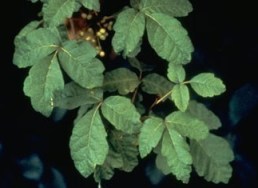
Poison ivy, poison oak, and poison sumac are plants that can cause a skin rash called allergic contact dermatitis.The rash is caused by contact with Urushiol oil found in all parts of the plants, including the leaves, stems, flowers, berries, and roots. All parts of the plants are poisonous all throughout the year. Urushiol is an allergen, so the rash is actually an allergic reaction to the oil in these plants. Indirect contact with urushiol can also cause the rash. This can happen when you touch objects that have come in contact with one of these plants. Urushiol oil can remain active for as long as 5 years so handling dead leaves, vines, or objets that have been in contact with the oil can cause a reaction. Wash tools and other objects with a dilute bleach solution or rubbing alcohol.
1/4 ounce of urushiol is all that is needed to cause a rash on every person on earth.
The rash usually appears 8 to 48 hours after your contact with the urushiol. But it can occur from 5 hours to 15 days after touching the plant. The rash usually takes more than a week to show up the first time you get urushiol on your skin. But the rash develops much more quickly (within 1 to 2 days) after later contacts. The rash will continue to develop in new areas over several days but only on the parts of your skin that had contact with the urushiol or those parts where the urushiol was spread by touching. The rash can last anywhere from a week to 3 weeks, depending on how bad it is and how you treat it. Prescription remedies make it go away much faster. If any of the plants are burned and the smoke then inhaled, this rash will appear on the lining of the lungs, causing extreme pain and possibly fatal respiratory difficulty.
Urushiol binds to the skin on contact. Common symptoms of the rash are:
- Itchy skin where the plant touched your skin.
- Red streaks or general redness where the plant brushed against the skin.
- Small bumps or larger raised areas (hives).
- Blisters filled with fluid that may leak out.
Poison Ivy Identification
~Rhymes can help describe the characteristic appearance of poison ivy.~
"Leaflets three; let it be" - Is the best known. It applies to poison oak, as well as to poison ivy.
"Longer middle stem, stay away from them." - This speaks to the middle leaflet having a visibly longer stem than the two side leaflets.
"Raggy rope, don't be a dope!" & "Hairy vine, no friend of mine." - Both refer to the Poison ivy vines on trees have a furry "raggy" appearance. Old, mature vines on tree trunks can be quite large and long, with the leaves obscured among the higher foliage of the tree.
"Berries white, run in fright" and "Berries white, danger in sight." - Pertains to the berries found on poison ivy.
"Red leaflets in the spring, it's a dangerous thing." - This refers to the red appearance that new leaflets sometimes have in the spring.
"If it's got hair, it won't be fair." - Makes mention of the hair that can be on the stem, and leaves of poison ivy.
Poison sumac is far more virulent than its both poison ivy and poison oak. According to some botanists, poison sumac is the most toxic plant species in the United States.
First Aid for Urushiol Oil Rash
- Because the plant oil enters skin quickly, try to wash it off within 30 minutes.
- Wash the skin thoroughly with soap and warm water several times in succession, use a fresh solution for each wash.
- Confine the washing to the affected area to avoid spreading the oil to other parts of the body.
- Scrub under the fingernails with a brush to prevent the plant oil from spreading to other parts of the body.
- Do not dress the affected area, this will cause retention of moisture and will not allow the area to dry.
- Body heat and sweating can aggravate the itching. Stay cool and apply cool compresses to your skin.
- Make a cool compress by running a clean washcloth under cold water and wringing it out so that it does not drip. Then apply the cool cloth to the itchy skin.
- Calamine lotion and hydrocortisone cream can be applied to the skin to reduce itching and blistering.
- Take short lukewarm baths in a colloidal oatmeal preparation, which you can buy at your local drugstore.
- Take short lukewarm baths, and add 1 cup of baking soda to the running water.
- Aluminum acetate (Domeboro solution) soaks can help to dry the rash and reduce itching.
- Antihistamine pills can help, but do not apply an antihistamine to your skin. Doing so can worsen the rash and the itch.
- In severe cases, especially for a rash around the face or genitals, a health care provider may prescribe steroids.



